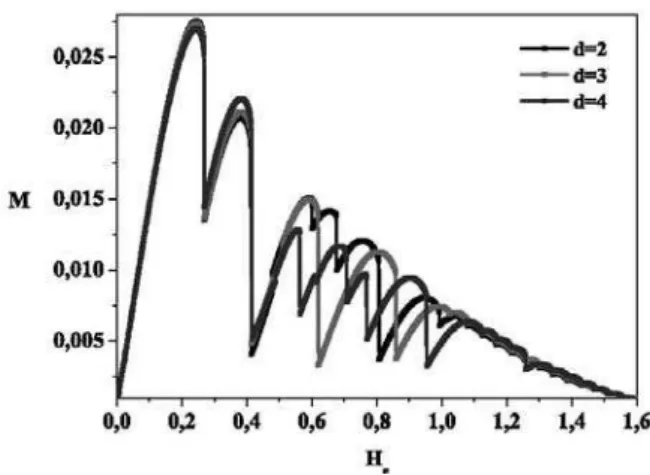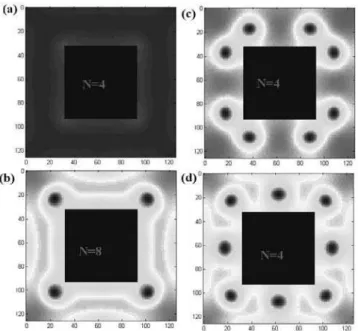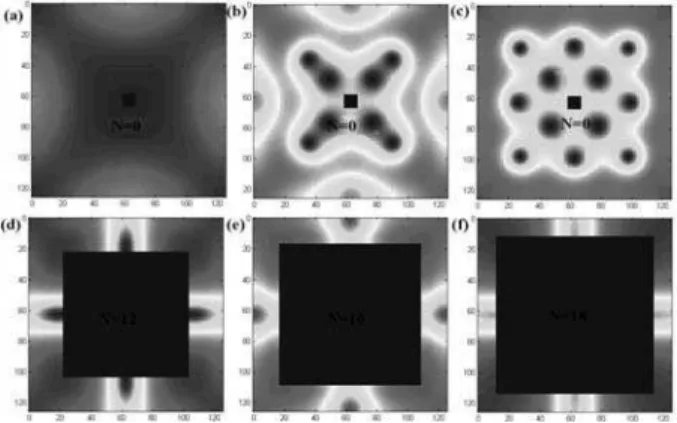Brazilian Journal of Physics, vol. 39, no. 3, September, 2009 673
Effect of an columnar defect on vortex configuration in a superconducting mesoscopic sample
J. Barba-Ortega
Departamento de F´ısica, Universidade Federal de Pernambuco, 50670-901, Recife, Brasil
Ariel Becerra
Grupo Integrar, Departamento de F´ısica, Universidad de Pamplona, Colombia
J.D. Gonz´alez
Grupo de Investigacion en Teoria de la Materia Condensada, Universidad del Magdalena, A.A. 731, Santa Marta, Colombia
(Received on 6 July, 2009)
In this work we investigate the vortex dynamics in a square mesoscopic superconducting cylinder in the presence of an applied magnetic field parallel to its axis. The rectangular cross-section of the sample isL2and an engineered columnar defect of aread2 at the center is taken into account;L=12ξ(0)for all simulations whiled varies discretely from 1ξ(0) to 10ξ(0). We study the magnetization and the vortex configuration, increasing the magnetic field from zero to the normal state field. We found that ford≥7ξ(0)no vortices in the superconductor area are possible. Also, if the size of the defect is reduced, the nucleation fields decrease. Keywords: Ginzburg-Landau, columnar defect, Mesoscopics samples, Superconducting
I. INTRODUCTION
The progress of nanofabrication technologies during the last years has resulted in an increased interest in the study of superconducting properties of mesoscopic samples. For type II superconductors the magnetic field, in the so called mixed state, penetrates in the form of vortices, which carry a flux quantum, and form a triangular lattice. For mesoscopic samples, i.e. for a sample of the order of penetration depth, the superconducting properties such as the critical fields, the critical current, the vortex lattice and the vortex itself, can present new and very interesting properties, as for example an increase in the critical field and giant vortices carrying more than one quantum flux [1, 2], the effect of defects on two and three dimensional samples on vortex configurations were studied by [5–8]. Several phenomenological theories have been developed during the decades of research in su-perconductivity. The London theory, the Ginzburg - Lan-dau theory and its time dependent extension, known as Time Dependent Ginzburg - Landau (TDGL) theory have been widely used during the years of research into superconduc-tivity [3, 4]. In previous work, we have studied the properties of mesoscopic superconducting samples surrounded by dif-ferent metallic materials using TDGL equations [9–11]. We numerically solve the nonlinear TDGL equations to study vortex dynamics in a mesoscopic type II cylinder supercon-ductor containing one square defect in the presence of an external field applied perpendicular to the surfaces. We an-alyze the defect size on the vortex configuration, magnetiza-tion curves and vortex number. It is assumed that the inner defect edge is in contact with a vacuum. The dynamics of different vortex states and the magnetization curves are stud-ied as a function of the external magnetic field.
II. THEORETICAL FORMALISM
Time dependent Ginzburg Landau equations in a zero electric potential gauge and in normalized units lead to the
following mathematical problem for the order parameterψ and the vector potentialA[12, 13]:
∂ψ ∂t =−
1 η h
(−i∇−A)2ψ+ (1−T)|ψ|2−1
ψi (1)
∂A
∂t = (1−T)Re[ψ
∗(−i∇−A)ψ]−κ2∇×∇×A (2)
Where lengths have been scaled in units of ξ(0), time in units of t0 =π~/(96KBTC), A units of HC2(0)ξ(0), temperatures in units ofTC.
We usedUψ method [4] for solve the TDGL equations in a discrete grid. Complex link variables
U
x andU
y areintroduced to preserve the gauge-invariant properties of the discretized equations.
U
xandU
yare related to A by:.U
x(x,y,t) =exp−i
Z x
x0
Ax(ξ,y,t)dξ
(3)
U
y(x,y,t) =exp−i
Z y
y0
Ay(x,η,t)dη
(4)
The link variable method is used since a better numerical convergence is obtain in high magnetic fields [12]. The TDGL equations 1 and 2 can be written in the following form:
∂ψ ∂t =
U
¯x∂2(
U
xψ)∂x2 +
U
¯y ∂2(U
yψ)
∂y2
+ (1−T)ψ 1− |ψ|2 (5)
Jsα= (1−T)Im
¯
U
αψ¯∂(U
αψ)∂α
(6)
674 J. Barba-Ortega et al.
simulation procedure is as follows: the sample is divided in a rectangular mesh consisting of Nx×Ny cells, with mesh spacingax×ay. To derive the discrete equations let us define byxi= (i−1)ax,yi= (i−1)ay, an arbitrary vertex point in the mesh and:
Ui,xj=
U
¯i,xj
U
xi+1,j=exp−i
Z xi+1
xi
Ax(ξ,yi)dξ
Ui,yj=
U
¯y i,jU
x
i,j+1=exp
−i
Z yj+1
yj
Ay(xi,η)dη
Li,j=Ui,jxUiy+1,jU¯ x i,j+1U¯
y
i,j=exp(−iaxayHe) Then the discretized version of the TDGL equations main-taining second order accuracy in space are gyven by:
∂ψi,j
∂t =
Ui,xjψi,j−2ψi,j+U¯ix−1,jψi−1,j
ηa2 x
+
Ui,jyψi,j+1−2ψi,j+U¯i,jy−1ψi,j−1 η2
y
−1−T
η (ψ¯i,jψi,j−1)ψi,j+f˜i,j ∂Ux
i,j
∂t =−i(1−T)U
x
i,jIm ψ¯i,jUi,xjψi+1,j
−
κ2 a2 y
Ui,xj(L¯i,j−1Li,j−1)
∂Ui,yj
∂t =−i(1−T)U
y
i,jIm ψ¯i,jUi,xjψi,j+1
−
κ2 a2 x
Ui,yj(L¯i,jLi−1,j−1)
The discretized open boundary conditions are: ψ1,j=ψ2,jU1x,j
ψNx+1,j=ψNx,jU¯Nx,x j
We use the simple Euler method with 107steps,∆t=0.0015, spacingax=ay=0.25. H~e is increased linearly with time from 0 to 1, with small intervals of∆H=10−7,κ=5,T =0 for all simulations.
The procedure consists of beginning of certain value of the applied magnetic fieldHeand the order parameterψ(r,t=0), i.e. the variables are homogeneously initialized to a perfect Meissner stateψ(t=0) =1,A(t=0) =0 (for every point in the domain). The stationary state found for a fixedHeis used then as initial condition for the next field valueH+∆H, using small increments of∆H. The applied magnetic field is increased smoothly from zero to a value where the super-conductivity will be destroyed completely. For each applied field we follow the temporary evolution of the magnetic in-duction and of the superconducting order parameter to obtain a stationary solution.
We considered a mesoscopic superconducting cylinder with a rectangular cross section L2 with an engineered columnar defect of aread2 at its center. The TDGL equa-tions are used upon taking the magnetic field and the order parameter invariant alongz-direction led to bi-dimensional
Fig. 1. Magnetization curves as function of the applied external field for a cylinder ofL=12ξ(0), with a centered defect with
d/ξ(0) =2,3,4.
Fig. 2. Magnetization curves as function of the applied external field for a cylinder ofL=12ξ(0), with a centered defect with
d/ξ(0) =5,6,7.
numerical treatment. The superconducting wave function satisfies the boundary conditionsn.(b −i∇−A)ψ=0, where b
ndenotes the normal vector to the superconductor - vacuum interface, and the boundary conditions forA, namely that Bz =ebz.∇×A at the external surface must equal He, the applied field. The defect has the following dimensions: d=1ξ(0)tod=10ξ(0)andL=12ξ(0).
III. RESULTS
Brazilian Journal of Physics, vol. 39, no. 3, September, 2009 675
Fig. 3. Magnetization curves as function of the applied external field for a cylinder ofL=12ξ(0), with a centered defect with
d/ξ(0) =8,9,10.
Fig. 4. Snapshot of the vortex configuration ford=6ξ(0)and (a)
N=4, (b), (c) and (d)N=12 at
He/Hc2(0) =0.40,0.840,0.845,0.847 respectively, blue and red
regions represents values of the modulus of the order parameter from 0 to 1.
d=1,2,3,4,N=30 ford=5,6,N=32 ford=7,8,N=44 ford=9 andN=72 ford=10. The vortex number in the sample increases as defect size increases. For a defectd≥7, the sample has ring superconductor behavior, Hc2 increase and no vortices are possible in the superconductor region, Hc1remains constant for all samples. We do not include the sample withd=1 in order for the figure to be better visual-ized.
The magnitude of the order parameter |ψ| is plotted in Figures 4 for a sample with d=6ξ(0). In Figs. 4(a - d), values of the order parameter close to zero are given by blue regions and close to 1 by red regions.
In Fig. 4(a) the first four vortices will be located in the
defect. Although they are not visible in the contour plot of the magnitude of order parameter, there is a change in the phase around each hole equal to∆φ=8π. The phase allows us to determine the number of vortices in a given region, by counting the phase variation in a closed path around this region. If the vorticity in this region is N, then the phase changes by ∆φ=2πN [13]. By increasing the magnetic field eight more vortices appear in the sample, as shown in Fig 4(b). They are localized in the superconductor region and goes to the defect corner. Then, in Fig. 4(c), eight vortices are situated in the hole and four vortices are in the superconducting region, while four vortices are going out of the defect. In Fig 4(d), withN=12, four vortices remain in the defect hole and eight in the superconducting region. All the states are not stationary states.
In the next tables we shown the magnetic field He with the pair of vorticities - inside and outside the defect.
He Ninside Noutside Ntotal
0.20 0 0 0
0.24 0 2 2
0.42 0 4 4
0.60 0 6 6
0.64 0 8 8
0.72 0 10 10
0.98 0 12 12
TABLE I: Vorticies inside and outside the defect for a sampleL= 12ξ(0)andd=1ξ(0)
He Ninside Noutside Ntotal
0.20 0 0 0
0.24 0 2 2
0.39 0 4 4
0.57 2 4 6
0.70 4 6 10
0.95 6 8 14
1.00 6 8 14
TABLE II: Vorticies inside and outside the defect for a sampleL= 12ξ(0)andd=4ξ(0)
He Ninside Noutside Ntotal
0.20 4 0 4
0.40 4 2 6
0.45 4 4 8
0.50 4 6 10
0.840 4 8 12
0.845 8 4 12
0.847 4 8 12
TABLE III: Vorticies inside and outside the defect for a sampleL= 12ξ(0)andd=6ξ(0)
676 J. Barba-Ortega et al.
Fig. 5. Snapshot of the vortex configuration ford=1ξ(0)for (a)
He=0.2Hc2(0),N=0. (b)He=0.72Hc2(0),N=10. (c) He=0.9Hc2(0),N=12 andd=8ξ(0)for (d)He=0,86Hc2(0),
N=12.d=9ξ(0)for (e)He=1.04Hc2(0),N=16 and d=10ξ(0)for (f)He=1.11Hc2(0).N=18.
sample withd=1ξ(0)does not allow vortices in the defect, due to size restrictions. d>7ξ(0)does not present vortices in the superconductor area.
IV. CONCLUSIONS
We theoretically calculated the spatial distribution of the vortices in a cylindrical mesoscopic superconductor with one square defect. All the work done here is for an infinitely long sample with mesoscopic square cross section with size L=12ξ(0). The presence of the defect affects the vortex distribution, as well as the vortex entry. We observed a se-quence of transitions as the magnetic external field increases. Samples with defectsd≥7 do not present vortices in the su-perconductor area. Our results also show that, as we reduce the size of the defect, the nucleation field decreases. The main goal of this work is to determine the limit of the occur-rence of square ring superconductor behavior.
V. ACKNOWLEDGEMENTS
The authors thank to Helen Cater for useful discussions.
[1] L. Chibotaru, A. Celeumans, V. Bruyndoncx, V. Moshchalkov, Nature (London)348, 833 (2000).
[2] B. Baelus, F. Peeters and V. Schweigert Phys. Rev. B61, 9734, (2000).
[3] G. C. Buscaglia, C. Bolech and A. L´opez,Connectivity and Superdonductivity, J. Berger and J. Rubinstein (Eds.) Springer, 2000.
[4] D. Gropp, H. Kaper, G. Leaf, D. Levine, M. Palumbo and V. Vinokur, J. Comput. Phys.123, 254, (1996).
[5] R. de C. Romaguera, Mauro M. Doria and F. M. Peeters, Phys. Rev. B75, 184525, (2007). Phys. Rev. B75, 064505, (2007). [6] M. Doria, S. C. Andrade, Phys. Rev. B60, 13164, (1997). [7] E. Sardella, R.A. Freire, P. N. Lisboa-Filho, Physica C421,
41, (2005).
[8] E. Sardella, A. L. Malvezzi, P. N. Lisboa-Filho, Phys. Rev. B
74, 014512, (2006), Phys. Rev. B77, 104508, (2008). Physica. B403, 1494, (2008).
[9] Jos´e J. Barba, Cl´ecio C. Souza, L. Cabral and J. Albino Aguiar, Physica C468, 718 (2008).
[10] J. Barba-Ortega and J. Albino Aguiar, Journal of Physics: Conference series150, 052015 (2009).
[11] J. Barba-Ortega and J. Albino Aguiar, Physica C 469, 754 (2009). Physica C469, 852, (2009).
[12] R. Kato, Y. Enomoto and S. Maekawa Phys. Rev. B,44, 6916 (1991).


